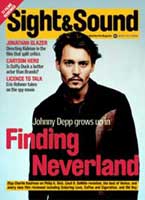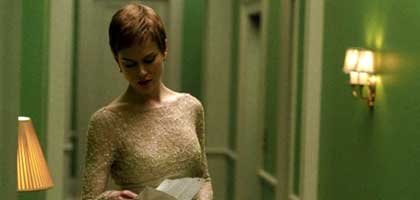
Grief Encounter

Jonathan Glazer's Birth evokes the numb mood of his ads and videos to underscore its creepy theme. Roger Clarke approves
Birth has had a tricky gestation - and birth. It's the story of a ten-year-old boy who convinces New Yorker Anna (Nicole Kidman) that he's the reincarnation of her dead husband. Though full of shadows and grief, it has been reported on in sensationalist mode. Following its Venice premiere, the Lido was buzzing with hacks discussing putative paedophile controversies (there's a naked bath scene with the boy and Kidman), booings at public screenings and Lauren Bacall's comment on her co-star (she correctly said it was too early to say whether Kidman is a "legend"). It's been a tale so far of false feuds, grumbling puritanical outrage and gossip. I caught up with director Jonathan Glazer on the Jewish Day of Atonement, and after his synagogue visit we managed to conduct a late-night conversation about the film.
Glazer is the most gifted director to have emerged from the UK advertising field for many years; his music videos for Radiohead, Blur and U.N.K.L.E are also remarkable for their imagery and technique. Radiohead's 'Street Spirit' promo is still considered one of the best of its kind; Blur's 'The Universal' is set in the Korova Milk Bar from Stanley Kubrick's 1971 A Clockwork Orange with Damon Albarn et al drooged up to the nines with eyeliner and stylised menace. Looking at this output, we see a world of padded cells, slow-motion accidents and freakish loners - a world also exploited in Glazer's commercials for Stella Artois, Wrangler jeans and his Guinness mini-movies. Faces loom out of Glazer's productions like phantoms waking from the dead, or patients sluggishly negotiating the end of a coma. Men are often stripped to the waist, or struggle through tunnels of raging traffic or along darkened American country roads. If they're in an apartment, like Richard Ashcroft in 'A Song for the Lovers', it feels like the ante-room to the afterlife or a creepy suite from Kubrick's 2001, The Shining or Eyes Wide Shut.
Glazer's feature debut was the metaphysical Cockney crime caper Sexy Beast (2000), featuring Ray Winstone and an Oscar-nominated performance from Ben Kingsley. When we first encounter Winstone he's sunning himself at his Spanish poolside (not a pretty sight), soaking up the warmth the way Kidman in Birth soaks up the autumn chill. The film's continued popularity is greedily exploited by contemporary Sky satellite trailers for its cinema channels - proof, if proof were needed, that Sexy Beast exists on a folk level and confirmation that Glazer managed briefly to revive the strip-mined British genre of the geezer flick. Sexy Beast is rich and strange, profane where Birth is sacred.
Glazer's films are full of arrivals and birth canals. There's an undeniably amniotic sequence in Sexy Beast in which Winstone and his gang break into a flooded tunnel. Elsewhere a dead Kingsley threatens to struggle up through the floor of Winstone's swimming pool, a fear realised from his dreams, slouching towards metempsychosis. The motif of different worlds, different rooms, suffuses the film. And look: here's a young boy too, a dark, semi-naked youth who cleans Winstone's pool, a creature of the sun-cracked Spanish soil, almost a sprite. One also remembers the stripped-to-the-waist boy in 'Street Spirit' - an uncanny white child who watches chairs fly through the air as Thom Yorke warbles. I'm not surprised when Glazer tells me he's interested in archetypes; he often deals in a cracked version of Jung's Puer Aeternus.
In the opening shot of Birth - conducted by Steadicam inventor Garrett Brown in one of his rare returns to the technique he pioneered - a man dies in a tunnel in New York's Central Park while out jogging in the snow. The man, barely seen, is Anna's first husband Sean. The tunnel seems familiar from other movies, and its location gives a clue to what's to come. Central Park has been a key character in many New York films, often used to suggest escape and transformation: think of Louise Brooks on a day out in Love 'Em and Leave 'Em (1926), of Cat People (1943) or of Jack Nicholson turning into a wolf in Wolf (1994). This is the world of fairytale - an important word in my conversation with Glazer.
As with Raúl Ruiz's Comédie de l'innocence (200o) - a movie to which Birth bears uncanny similarities, though Glazer hasn't seen it - a public park plays a crucial role in a late revelation. Glazer tells me he'd intended this opening shot to be on a wire/rig - flying and looking down - but had to re-think on the spot when it became clear the authorities wouldn't let him remove branches and leaves from some trees. Garrett Brown had been hired for a single day; he decided the shot was now impossible and volunteered to break out the Steadicam. Since The Shining was a key inspiration (along with Rashomon and Carl Dreyer's The Passion of Joan of Arc), it was a magical moment for the crew to have that film's Steadicam operator quietly going about his business. As Sean dies unnoticed on a cold winter's day, in the darkness of a tunnel with snow piled brightly beyond it, where does his spirit fly? This is the essence of the story.
Glazer admits that after he cast Cameron Bright as the second Sean, the boy who ten years later demonstrates an uncanny knowledge of Anna's marriage as he petitions her to be re-admitted into her life, he had to rewrite much of the script. "There's a real sobriety and austerity there," he says of the child actor. The director was anxious to avoid the "creepy kid" connotations of Bright's previous feature Godsend (2003), a B-movie horror flick in which he plays a demonic munchkin. "I think I'd been looking for a kid with more obvious empathy - maybe 12 or 13 years old - and initially I went right past Cameron. But Jean-Claude Carrière, who worked on the original script, always told me to stay young with the kid, because as soon as you get to adolescence it's a different story. So I went back to Cameron, who was nine at the time, and found something very adult in him - and something very vague, which allows Anna to imbue him with what she wants."
As the film develops, the child's plea works effectively and feverishly on Anna's mind. Perhaps he really is telling the truth. A whole monograph could be written on the class aspects of Birth (the boy is working class), which Glazer acknowledges and ascribes to Carrière's background as a Luis Buñuel writer (including, ironically, if not just for the title, 1977's That Obscure Object of Desire).
Glazer didn't initially send Kidman the script (which he rewrote right up to the wire with Monster's Ball screenwriter Milo Addica); she chanced upon a copy and contacted him herself. "She wasn't the actress I had in mind. Robin Wright Penn was on the cards for a while. But I met Nicole when I was in LA raising the production money and we had lunch; before I got there I knew I'd recognise if she was right pretty quickly. There was also the concern about the exposure her celebrity would bring and whether I was happy with that. But she got the script almost entirely and she had a very peculiar response to it: she talked about it as if she'd written it herself. I offered her the role after 20 minutes." Doesn't Kidman have a son aged about ten? "I gotta be honest with you, we never had a personal conversation. It was always about the script."
One of the most remarkable scenes comes midway through the film when Kidman and her fiancé Joseph go to the opera in New York. Wagner's second prelude to The Ring cycle is being staged (the first prelude gets used in the film's closing moments) and the music fills the scene while the camera slowly zooms in on Kidman's face as the full horror and delight of the situation cascades silently within her: the thought of her dead husband in the body of a boy and the ensuing backwash of dementia. It's a masterpiece of spine-chilling micro-acting. When I ask Glazer about his choice of music I'm surprised to learn he hadn't had this exact piece in mind; Verdi was considered and the scene was shot to the first prelude that ends the film. "But the second prelude has a sense of things moving on and I wanted that." The incidental music, calm and clear with a touch of The Exorcist about it, is by Alexandre Desplat. "I didn't want a score that was emotionally leading - a score with leitmotifs telling you who everyone is," Glazer says. "Then we hit on the idea of the fairytale - it was so useful and so full of hope and innocence."
Cinematographer Harris Savides recalls this musical decision being translated into the visuals. Savides - responsible for the gliding camerawork in Elephant and for something of the ominous tone of Se7en - says that Glazer asked him to make Kidman and her Upper West Side life look cool and palatial, like the ivory tower of the cliché. "The film was underexposed and underdeveloped," he tells me from New York. "Then we graded it by doing some tests and finding the level we liked. Everything in the interiors was lit from overhead with light bounce, through stretched muslin over the whole set. I light a room and let the actors inhabit it, I don't light faces. It gives the look an integrity."
